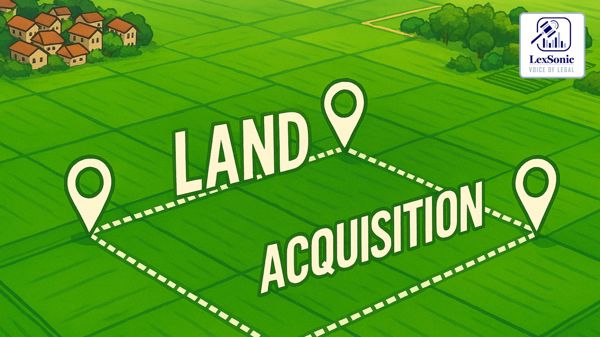Supreme Court Denies Land Release but Orders Compensation Under 2013 Act in Long-Pending Acquisition Case.
01 April 2025
Civil Appeals >> Civil & Consumer Law | Land Acquistion >> Property & Real Estate
The Supreme Court of India has dismissed an appeal in Kishore Chhabra v/s The State Of Haryana & Others., seeking the release of land acquired by the State of Haryana in 1992 for development in Sonipat. The appellant, claiming continuous possession and operation of a factory on the acquired land, had challenged the rejection of his representation for release. While the court declined to order the release, citing the appellant's lack of a valid Change of Land Use (CLU) certificate and the significant development already undertaken by the State, it invoked its powers under Article 142 of the Constitution to direct compensation to be calculated as per the Right to Fair Compensation and Transparency in Land Acquisition, Rehabilitation and Resettlement Act, 2013.
Background of the Acquisition and Appellant's Claims:
The appellant became the owner of two land parcels in Sultanpur, Sonipat, in 1986, where a factory was reportedly operational since 1970. In 1992, the State of Haryana issued a notification under Section 4 of the Land Acquisition Act, 1894, for a large-scale acquisition of land, including the appellant's, for residential and commercial development. A Section 6 notification followed in 1993, and the Land Acquisition Collector passed an award in 1995, stating that possession had already been taken.

The appellant unsuccessfully challenged the acquisition in previous writ petitions. The present appeal arose from the dismissal of his third writ petition, which contested the State's 2010 order rejecting his plea for land release. The appellant argued discrimination, pointing to the release of land belonging to other entities within the same acquisition notification, and claimed his factory's pre-existing status should qualify him for release under the State's policies. He also contended that the rejection order lacked reasons.
State's Counterarguments:
The State of Haryana opposed the release, citing significant delay and laches in the appellant's repeated challenges, the alleged taking of possession, and the appellant's failure to possess a valid CLU, a fundamental requirement under the State's town planning regulations. The State also argued that the appellant's land fell within a designated green belt and that substantial public funds had already been invested in the development of the acquired area. The State distinguished the release of other landowners' properties, asserting they were either granted CLU before the Section 4 notification or pertained to different land parcels or policies.
Supreme Court's Analysis: The Crucial Issue of CLU:
The Supreme Court focused on the core issue of the CLU. It noted that the appellant's land fell within a controlled area since 1964, necessitating a CLU for any development. The appellant failed to produce any CLU granted in his or his predecessor's favor. The court emphasized that a CLU is a statutory prerequisite for validating the operation of a factory and thus for inclusion under the State's release policies of 1991 and 2007, which favored pre-existing factories. The State's specific assertion of the appellant's lack of CLU, which remained unrebutted by the appellant, proved decisive on this point.
Rejection of Discrimination Plea:
The appellant's plea of discrimination was also rejected. The court analyzed the instances of land release cited by the appellant. It found that the release of Devraj Dewan's land occurred after an application for CLU was processed and granted even before the Section 4 notification. Similar distinctions were drawn for other released lands, with the State clarifying that some were not part of the same notification or involved land not designated for green belt or roads. The court concluded that the appellant's lack of a valid CLU placed his case on a different footing.
No Delay or Res Judicata:
The court, however, found no merit in the State's arguments of delay, laches, and res judicata. It noted that the State had considered the appellant's release request as late as 2020-21, and the appellant had been pursuing his case since 2007-08. The first writ petition was not for release, and the second was withdrawn due to the pending representation. Thus, the release issue had never been considered on merits by the High Court.
Extraordinary Relief Under Article 142:
Despite dismissing the appeal for land release, the Supreme Court invoked its extraordinary powers under Article 142 of the Constitution. Acknowledging the appellant's claim of continuous physical possession and the operation of a factory, which the State had not convincingly refuted, the court deemed it appropriate, on the specific facts of the case, to direct that the compensation payable to the appellant be calculated according to the provisions of the Right to Fair Compensation and Transparency in Land Acquisition, Rehabilitation and Resettlement Act, 2013, as on the date of its commencement. The court explicitly stated that this order was specific to the unique circumstances of this case and should not serve as a precedent in other matters.
Conclusion:
The Supreme Court, while upholding the High Court's dismissal of the land release plea due to the appellant's lack of a valid CLU and the advanced stage of development, provided a measure of relief by directing compensation under the more beneficial 2013 Act. This decision highlights the importance of adhering to statutory land use regulations while also considering the equities arising from prolonged possession and operational status in land acquisition matters.
